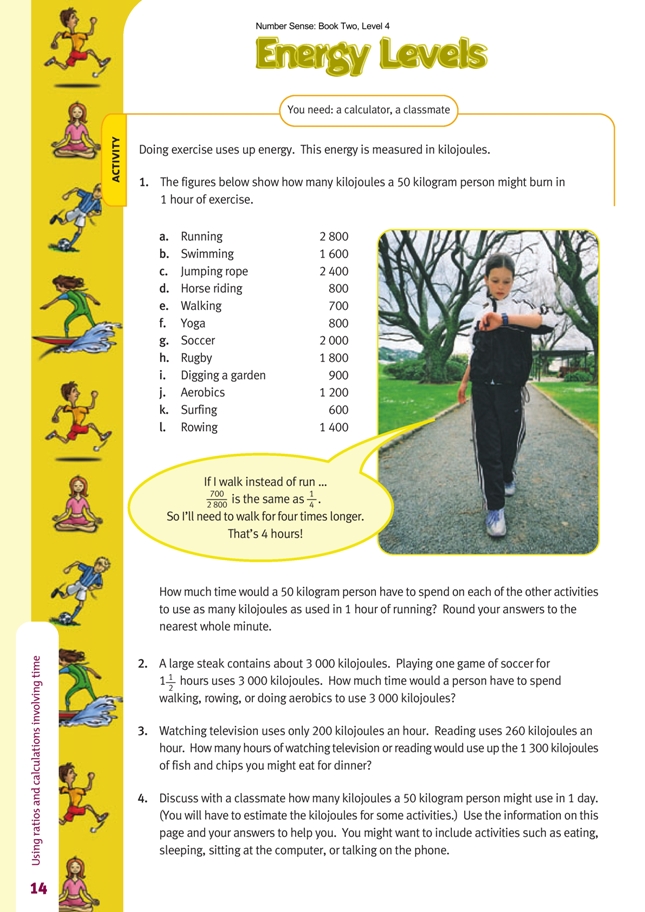This is a level 5 number activity from the Figure It Out series. It relates to Stage 8 of the Number Framework.
A PDF of the student activity is included.
Click on the image to enlarge it. Click again to close. Download PDF (609 KB)
solve problems involving rates and ratios
FIO, Level 4, Number Sense, Book Two, Energy Levels, page 14
A classmate
The questions in this activity work with two principal ideas: calculating how long different activities would need to be performed to give the same energy use and converting these times from decimal hours into minutes where necessary.
Question 1 is probably best tackled by considering how many times each of the kilojoule amounts divides into the 2 800 used up during running. The figure obtained for each form of exercise represents the number of hours that the exercise would have to be performed to equate with 1 hour of running. For example, walking
uses up 700 kilojoules; 700 x 4 is 2 800, so 4 hours’ walking would be the equivalent of 1 hour’s running. The speech bubble provides a closely related approach to the same problem.
This is fine for figures that divide evenly into 2 800 (such as the 1 400 for rowing and the 700 for walking). When it comes to the others, however, the decimal fraction obtained will need to be converted into hours and minutes. This is done by multiplying the decimal part of the result by 60 to give the number of minutes. In some cases, this is straightforward and can be done mentally. For example, in the case of horse riding and yoga, which each use up 800 kilojoules per hour, 800 divides into 2 800 exactly 3.5 times. This represents 3 1/2 hours or 3 hours 30 minutes. Swimming is also reasonably straightforward: 1 600 divides into 2 800 kilojoules exactly 1.75 times. This is 1 3/4 hours or 1 hour 45 minutes. (Note that the table of equivalences
among decimals and fractions suggested in the notes for page 6 of the student book could be used here. Of course, the calculator can be used, too, for example, 0.75 x 60 = 45, but why use a calculator when a mental calculation is faster?)
The other examples will result in decimal fractions that the students may or may not recognise. If they are not familiar with these decimal fractions, they can use a calculator to work out the number of minutes. For example, jumping rope uses 2 400 kilojoules. 2 400 divides into 2 800 kilojoules 1.16666times. 0.16666 is the decimal fraction equivalent of 1/6. If the students recognise this, they can then calculate that 1/6 of 60 minutes is 10 minutes. Otherwise, they can use a calculator to multiply 0.16666 x 60 minutes, which gives 9.99996 minutes. Rounding gives a time of 1 hour 10 minutes required for jumping rope. Times for the other activities can be calculated in a similar fashion.
Question 2 is similar to the first question except that, in this case, the key figure is the 3 000 kilojoules obtained from eating the steak. In each of the cases of walking, rowing, and doing aerobics, the number of times that the kilojoules/hour divides into 3 000 is the number of hours a 50 kilogram person would have to spend on that exercise to burn up the steak kilojoules. Walking, at 700 kilojoules, divides into 3000
kilojoules 4.2857 times, that is, 4 hours and 17 minutes (rounded to the nearest minute). Rowing, at 1 400 kilojoules, would require just half that time, that is, 2 hours 9 minutes (rounded to the nearest minute). Aerobics, at 1 200 kilojoules, divides into 3 000 kilojoules exactly 2.5 times, that is, 2 hours 30 minutes (so aerobics is the easiest of all to calculate).
Question 3 can be calculated using the same kind of strategy as for question 2. The 200 kilojoules used per hour watching television divides into the 1300 kilojoules gained from eating 6.5 times the amount of fish and chips. This means that one would have to watch television for 6 hours 30 minutes to burn off the fish and chips kilojoules. Less time would be required with reading. The 260 kilojoules per hour used during reading divides into 1 300 kilojoules exactly 5 times, meaning that 5 hours’ reading would be required.
For question 4, a range of student responses is possible and likely. Based on the data provided in questions 1 and 3, the students will have to estimate roughly how many kilojoules would be used in the other activities undertaken during a typical day. There will clearly be a large amount of conjecture in this. For example, you could ask the students to estimate how much energy the cycling might use, given the figures for other activities. The students should find it interesting to compare their results for different activities and for total daily energy use.
Answers to Activity
1. b. 1 hr 45 min.
c. 1 hr 10 min.
d. 3 hrs 30 min.
e. 4 hrs
f. 3 hrs 30 min.
g. 1 hr 24 min.
h. 1 hr 33 min.
i. 3 hrs 7 min.
j. 2 hrs 20 min.
k. 4 hrs 40 min.
l. 2 hrs
2. Walking: 4 hrs 17 min.
Rowing: 2 hrs 9 min.
Aerobics: 2 1/2 hrs
3. Television: 6 1/2 hrs
Reading: 5 hrs
4. Suggested kilojoules will vary.
